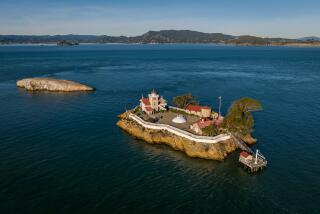Shedding Light on Baskets in Nautical Tradition
NANTUCKET, Mass. â Lightship basket making has become a fine traditional craft on this popular summer resort island just south of Cape Cod.
Internationally recognized as collectibles, the baskets are the islandâs most highly prized souvenirs.
The craft developed essentially as a means to fight boredom. In 1853, the U.S. Lighthouse Service positioned a lightship (a stationary floating lighthouse) at the treacherous Nantucket Shoals, site of many fatal sailing accidents. To pass the time, crewmen began weaving baskets to give to friends back home.
The baskets were fine and tightly woven--often with whalebone or ebony ornamentation or beautifully etched scrimshaw. When local citizens began weaving, too, lightship basket making became an island craft tradition. It also became a cottage industry.
The Lightship Nantucket is still moored at Straight Wharf (it can be boarded for tours), but the basket making has moved ashore. About one dozen lightship basket makers maintain studios around the island. They sell their baskets directly from their workshops--some only by special order--and in a handful of fine craft shops in the center of town.
Baskets usually are round or oval with staves of oak wood. They range in size from tiny âone-eggâ baskets to those as large as watermelons. Some are fitted with beautiful hand-carved wood or handmade iron handles and clasps, or with handles and clasps carved of whalebone or ivory.
Many of the baskets have tops made of polished woods, such as oak, rosewood, walnut and ebony. Some are decorated with carved whales, shells, sea gulls or beautiful ovals made of ivory, ebony or whalebone. Some are adorned with scrimshaw.
Baskets usually take six months to 1 1/2 years to make, and prices range from $100 to $11,000 for larger baskets elaborately decorated with scrimshaw.
Among the places to purchase them is Nantucket Basket Works, which is tucked away on Daves Street, about one mile outside town. Get there by taking a lovely walk along the waterâs edge toward the town of Sconset or by taxi for about $3. Three highly respected basket makers--Allan Reed, Nap Plank and Janet Bowman--work there, often collaborating on one basket.
Reed, who moved to Nantucket from the mainland in 1979 and has been making baskets ever since, suggests that there are a few hallmarks of excellent baskets.
âQuality of workmanship can be judged by whether the weave is straight, tight, even and without gaps, whether the caning is even in color and whether the top fits well,â he says. âWooden basket tops and handles should be smoothly finished, and the rim should be the same width all around.â
Itâs usually possible to see Reed, Plank or Bowman at Nantucket Basket Works. They keep a few baskets on hand (priced from $100 for a small basket to about $10,000 for large), but most of their work is made-to-order. Special orders usually take six months to a year to complete.
Four Winds Craft Guild, on Straight Wharf (at the end of Main Street), displays a large selection of baskets by several artists. The best are made by Paul Johnson (from about $800) and Donna Cifranic (from about $750). Johnson was the student of Jose Reyes, a master of lightship basketry who died in 1980. Reyes developed innovative weaving techniques and modern styles. Cifranic, in turn, learned from Johnson.
Johnson and Cifranic work independently. Both produce tightly woven baskets with strong staves and even caning and stitching. Johnson is also an accomplished carver, and his baskets are often adorned with carvings and clasps made of scallop shells, whalebone or tooth, ivory or ebony.
Other basket makers represented by the shop are Michael Bedell (from about $400), Mary Malavase (from about $400) and Charles Rogerson (from about $400).
One of Nantucketâs top scrimshanders, David Lazarus, has studio space in Four Winds Craft Gallery, and can be seen working on a piece for a basket made by Johnson or Cifranic.
Michael Kane, at 18 1/2 Sparks Ave., is recognized as one of the islandâs best basket makers. His baskets start at about $2,000.
Charles Sayle, who works with his wife Judy in a studio on Washington Street, is an exceptionally fine carver, credited with putting the first carving on a covered lightship basket in 1948. Saylesâ baskets are from about $500.
More to Read
Sign up for The Wild
Weâll help you find the best places to hike, bike and run, as well as the perfect silent spots for meditation and yoga.
You may occasionally receive promotional content from the Los Angeles Times.




